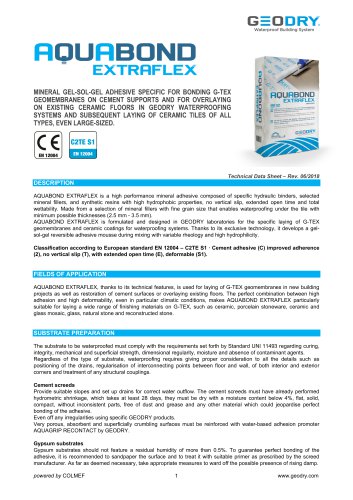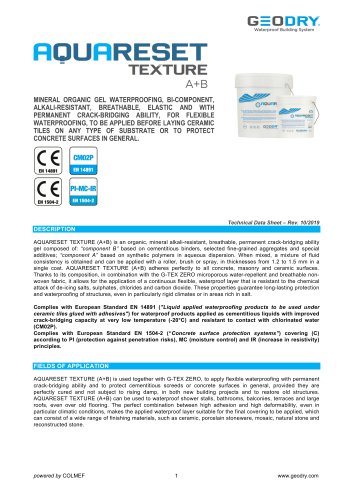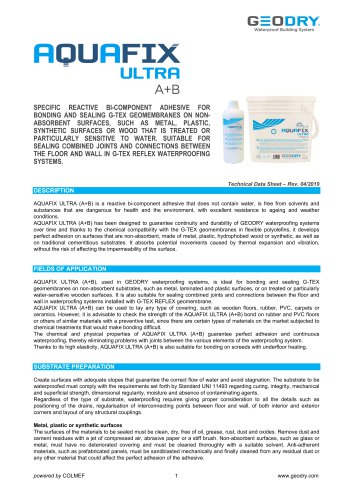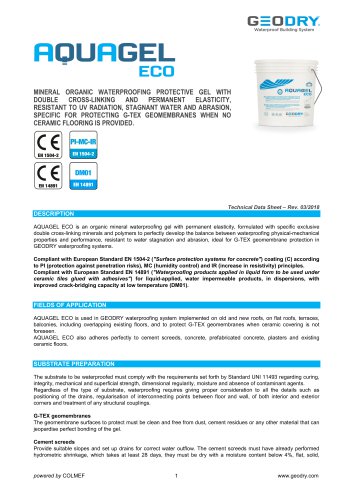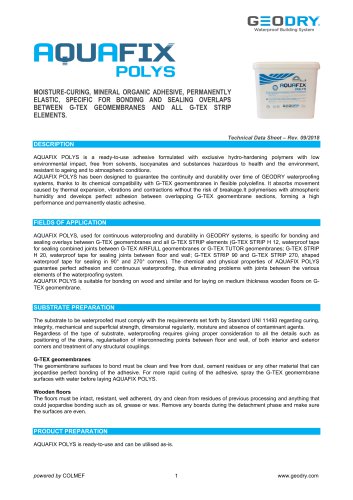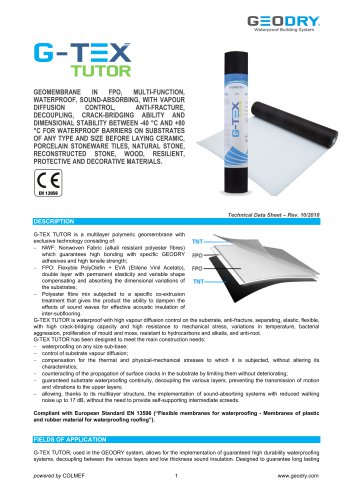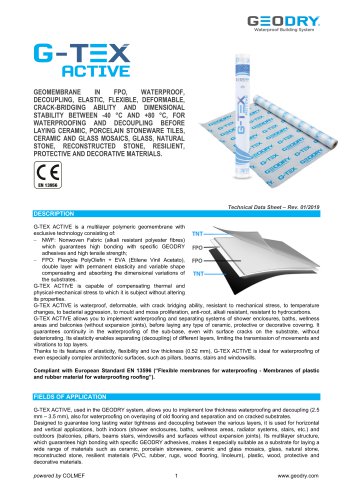
Catalog excerpts

MINERAL GEL-SOL-GEL ADHESIVE SPECIFIC FOR BONDING G-TEX GEOMEMBRANES ON CEMENT SUPPORTS AND FOR OVERLAYING ON EXISTING CERAMIC FLOORS IN GEODRY WATERPROOFING SYSTEMS AND SUBSEQUENT LAYING OF CERAMIC TILES OF ALL TYPES, EVEN LARGE-SIZED. Technical Data Sheet – Rev. 06/2018 DESCRIPTION AQUABOND EXTRAFLEX is a high performance mineral adhesive composed of specific hydraulic binders, selected mineral fillers, and synthetic resins with high hydrophobic properties, no vertical slip, extended open time and total wettability. Made from a selection of mineral fillers with fine grain size that enables waterproofing under the tile with minimum possible thicknesses (2.5 mm - 3.5 mm). AQUABOND EXTRAFLEX is formulated and designed in GEODRY laboratories for the specific laying of G-TEX geomembranes and ceramic coatings for waterproofing systems. Thanks to its exclusive technology, it develops a gelsol-gel reversible adhesive mousse during mixing with variable rheology and high hydrophilicity. Classification according to European standard EN 12004 – C2TE S1 · Cement adhesive (C) improved adherence (2), no vertical slip (T), with extended open time (E), deformable (S1). FIELDS OF APPLICATION AQUABOND EXTRAFLEX, thanks to its technical features, is used for laying of G-TEX geomembranes in new building projects as well as restoration of cement surfaces or overlaying existing floors. The perfect combination between high adhesion and high deformability, even in particular climatic conditions, makes AQUABOND EXTRAFLEX particularly suitable for laying a wide range of finishing materials on G-TEX, such as ceramic, porcelain stoneware, ceramic and glass mosaic, glass, natural stone and reconstructed stone. SUBSTRATE PREPARATION The substrate to be waterproofed must comply with the requirements set forth by Standard UNI 11493 regarding curing, integrity, mechanical and superficial strength, dimensional regularity, moisture and absence of contaminant agents. Regardless of the type of substrate, waterproofing requires giving proper consideration to all the details such as positioning of the drains, regularisation of interconnecting points between floor and wall, of both interior and exterior corners and treatment of any structural couplings. Cement screeds Provide suitable slopes and set up drains for correct water outflow. The cement screeds must have already performed hydrometric shrinkage, which takes at least 28 days, they must be dry with a moisture content below 4%, flat, solid, compact, without inconsistent parts, free of dust and grease and any other material which could jeopardise perfect bonding of the adhesive. Even off any irregularities using specific GEODRY products. Very porous, absorbent and superficially crumbling surfaces must be reinforced with water-based adhesion promoter AQUAGRIP RECONTACT by GEODRY. Gypsum substrates Gypsum substrates should not feature a residual humidity of more than 0.5%. To guarantee perfect bonding of the adhesive, it is recommended to sandpaper the surface and to treat it with suitable primer as prescribed by the screed manufacturer. As far as deemed necessary, take appropriate measures to ward off the possible presence of rising damp. powered by COLMEF
Open the catalog to page 1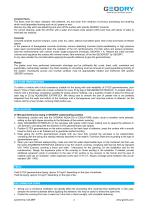
Ceramic floors The floors must be intact, resistant, well adherent, dry and clean from residues of previous processing and anything which could jeopardise bonding such as oil, grease or wax. Remove any tiles which are detaching and even off the surface with specific GEODRY products. For correct cleaning, wash the old floor with a water and caustic soda solution (30%) and rinse with plenty of water to eliminate any residues. Concrete Concrete surfaces must be compact, cured, solid, dry, clean, without inconsistent parts, free of dust and traces of release agents. In the presence of...
Open the catalog to page 2
Waterproof Building System ■ For laying large size ceramic materials, for laying outdoors, for laying in damp environments or subject to intense traffic, it is important to also spread the adhesive on the back side of the tiles. This will prevent any gaps from forming, which would cause breaks or detachment due to concentrated load pressure or frost reaction. ■ Do not use AQUABOND EXTRAFLEX for bonding G-TEX geomembrane on non-absorbent or metal surfaces, on treated wood or surfaces particularly sensitive to water, or on plastic or resilient materials. AQUABOND EXTRAFLEX is available in...
Open the catalog to page 3
substrate (to be calculated separately) which must comply with the requirements set forth by Standard UNI 11493 regarding curing, integrity, mechanical and superficial strength, dimensional regularity, moisture and absence of contaminant agents. For ceramic material laying: laying of ceramic, porcelain stoneware, ceramic and glass mosaic, glass, natural stone and reconstructed stone flooring and coverings with a variable rheological gel-sol-gel effect adhesive with high hydrophilicity, high performance, no vertical slip, extended open time and total wettability, classified as C2TE S1 in...
Open the catalog to page 4All GEODRY catalogs and technical brochures
-
AQUAPROOF GEOLASTIC A+B
5 Pages
-
AQUARESET TEXTURE A+B
5 Pages
-
AQUAFIX ULTRA A+B
3 Pages
-
AQUAGEL REFLEX
4 Pages
-
AQUAGEL ECO
4 Pages
-
AQUAFIX HYBRID
3 Pages
-
AQUAFIX POLYS
3 Pages
-
AQUASAFE ULTRATECH
4 Pages
-
AQUABOND RAPID
4 Pages
-
G-TEX REFLEX
6 Pages
-
G-TEX TUTOR
6 Pages
-
G-TEX AIRFULL
7 Pages
-
G-TEX INFINITY
8 Pages
-
G-TEX ACTIVE
6 Pages
-
Brochure GEODRY 2018
28 Pages

